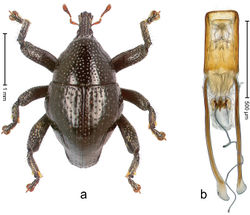Trigonopterus sepuluh
| Notice: | This page is derived from the original publication listed below, whose author(s) should always be credited. Further contributors may edit and improve the content of this page and, consequently, need to be credited as well (see page history). Any assessment of factual correctness requires a careful review of the original article as well as of subsequent contributions.
If you are uncertain whether your planned contribution is correct or not, we suggest that you use the associated discussion page instead of editing the page directly. This page should be cited as follows (rationale):
Citation formats to copy and paste
BibTeX: @article{Riedel2014ZooKeys, RIS/ Endnote: TY - JOUR Wikipedia/ Citizendium: <ref name="Riedel2014ZooKeys">{{Citation See also the citation download page at the journal. |
Ordo: Coleoptera
Familia: Curculionidae
Genus: Trigonopterus
Name
Trigonopterus sepuluh Riedel sp. n. – Wikispecies link – ZooBank link – Pensoft Profile
Diagnostic description
Holotype, male (Fig. 77a). Length 2.53 mm. Color black; antennae and tarsi ferruginous. Body in dorsal aspect subovate, with weak constriction between pronotum and elytron; in profile dorsally convex. Rostrum with median and pair of indistinct submedian ridges; intervening furrows containing row of coarse punctures, with rows of erect scales; epistome with subangulate ridge bearing five denticles. Head with front margin of eye bordered by distinct furrow. Pronotum with disk densely punctate with small punctures; interspaces subglabrous; each puncture containing small recumbent seta. Elytra with striae marked by small punctures; intervals flat, weakly microreticulate, with small interspersed punctures, especially on sutural interval; elytral apex subtruncate, in apical aspect ventral outline weakly bisinuate. Metafemur subapically with stridulatory patch. Dorsal edge of tibiae with subbasal angulation, dentate in pro- and mesotibia. Abdominal ventrites 1–2 subglabrous, with few long erect narrow scales, laterally with swollen rim; abdominal ventrite 2 in profile projecting dentiform; abdominal ventrite 5 flat, basally with indistinct transverse costa, with sparse coarse punctures and suberect scales. Penis (Fig. 77b) with sides of body subparallel; apex rounded, with sparse setae; transfer apparatus small, complex, wider than long; apodemes 1.9 × as long as body; ductus ejaculatorius without bulbus. Intraspecific variation. Length 2.16–2.55 mm. Female body between humeri slightly more slender. Female rostrum dorsally subglabrous, coarsely punctate, interspaces microreticulate; epistome simple.
Material examined
Holotype (MZB): ARC2538 (EMBL # LM655875), W-Kalimantan Prov., Bengkayan, Suka-Bangun, Mt. Bawang, sample 5, N00°54.103', E109°22.515', 652 m, 11-XII-2011 (MZB). Paratypes (MZB, SMNK, ZSM): 8 exx, ARC2539 (EMBL # LM655876), ARC2540 (EMBL # LM655877), ARC2541 (EMBL # LM655878), same data as holotype.
Distribution
W-Kalimantan Prov. (Mt. Bawang). Elevation: 652 m.
Etymology
This epithet is based on the Indonesian word for “ten” and is treated as a noun in apposition.
Notes
Trigonopterus sepuluh Riedel, sp. n. was coded as “Trigonopterus sp. 365” by Tänzler et al. (2014)[1].
Original Description
- Riedel, A; Tänzler, R; Balke, M; Rahmadi, C; Suhardjono, Y; 2014: Ninety-eight new species of Trigonopterus weevils from Sundaland and the Lesser Sunda Islands ZooKeys, (467): 1-162. doi
Images
|
Other References
- ↑ Tänzler R, Toussaint E, Suhardjono Y, Balke M, Riedel A (2014) Multiple transgressions of Wallace’s Line explain diversity of flightless Trigonopterus weevils on Bali. Proceedings of the Royal Society B: Biological Sciences 281: 20132528. doi: 10.1098/rspb.2013.2528
